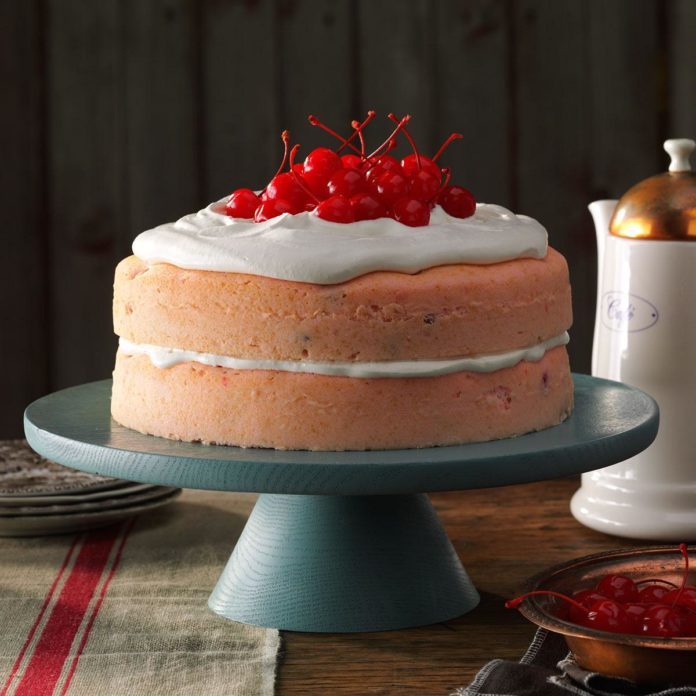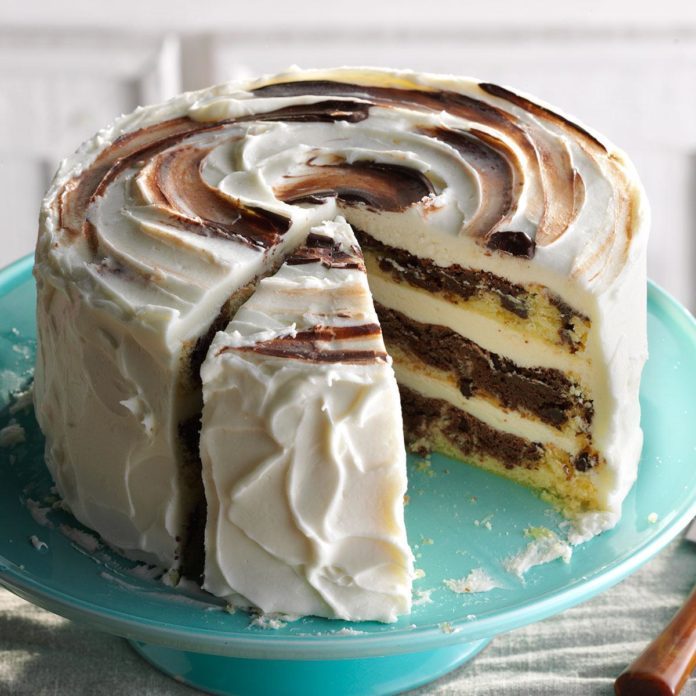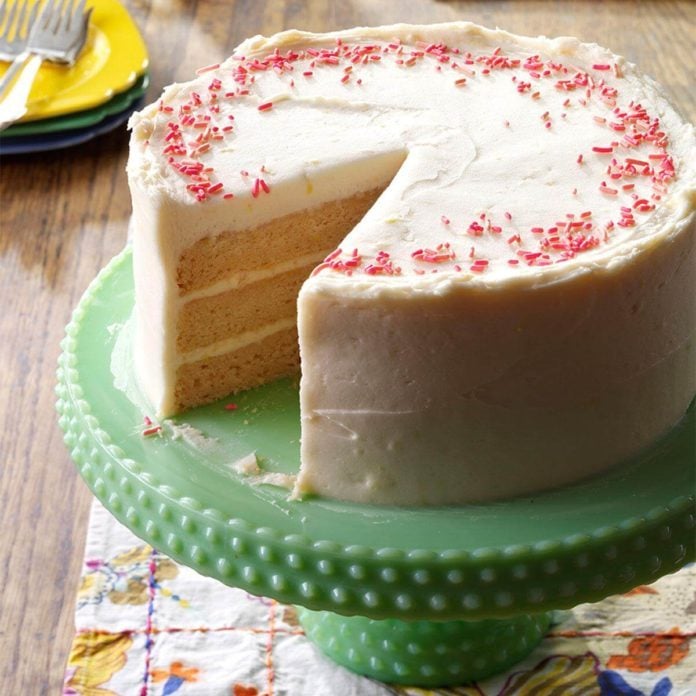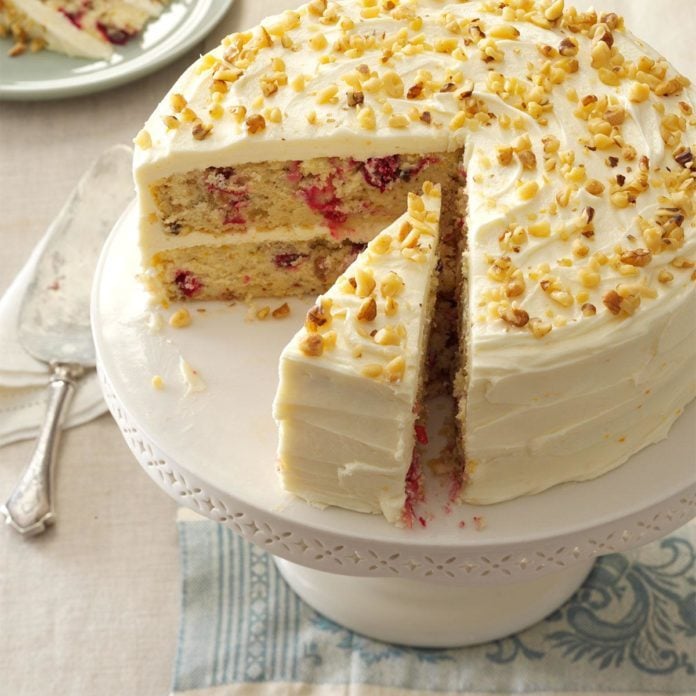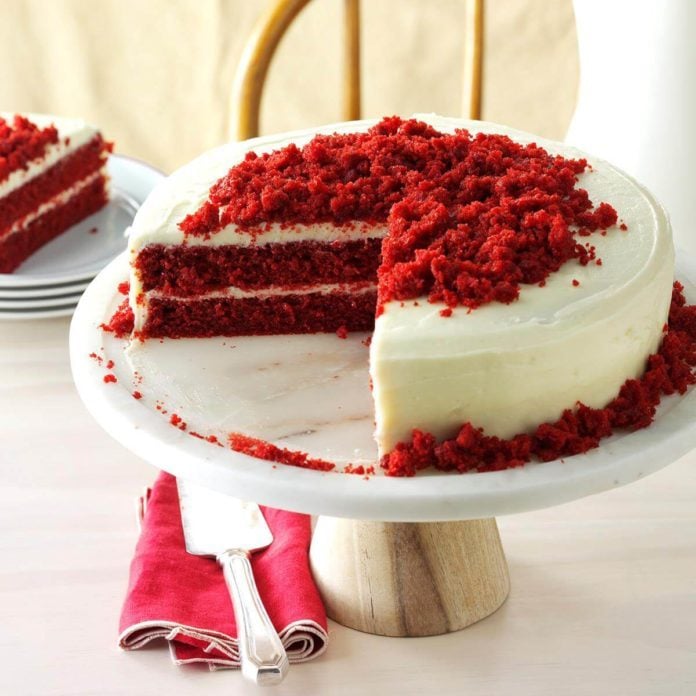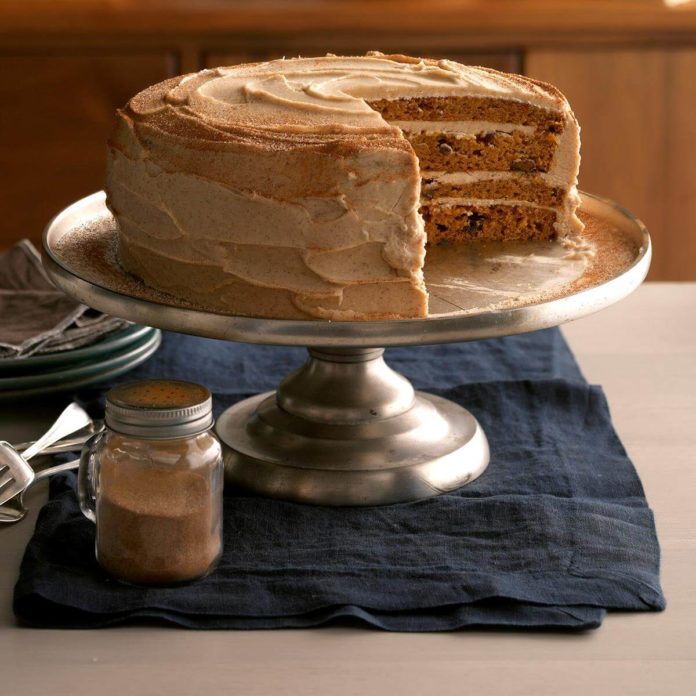Whether it’s a birthday, an anniversary, a baby on the way or just a job well done, having a great vanilla cake recipe in your baking repertoire is a good idea. A rich, moist and flavorful vanilla cake is a great people-pleasing dessert that can be dressed up for any special occasion. However, finding a recipe that manages to hit all those marks can be challenging—until now.
Maggie Knoebel, a culinary assistant in our Test Kitchen, spent months perfecting this white cake recipe. After dozens of practice cakes, she created the best vanilla cake any of us at Taste of Home have tried. It’s moist, lush and incredibly flavorful—a feat for vanilla cake. We’ll walk you through how to make Maggie’s masterpiece. You’ll definitely want this one on hand for your next celebration.
The Best Vanilla Cake Recipe

To make this showstopping cake, you’ll need some kitchen basics as well as your favorite vanilla extract and paste. A double dose here makes all the difference! Maggie also recommends her luscious vanilla buttercream frosting to top it all off.
Here are some of our favorite baking supplies to help you get started:
For the cake:
- 1-1/2 cups sour cream
- 1 tablespoon vanilla bean paste
- 1 tablespoon vanilla extract
- 4 cups cake flour
- 2-1/2 cups sugar
- 4-1/2 teaspoons baking powder
- 2 teaspoons salt
- 1 cup unsalted butter, softened
- 1/4 cup canola oil
- 6 large egg whites, room temperature
- 2 large eggs, room temperature
For the frosting:
- 6 ounces white baking chips
- 1/4 cup heavy whipping cream
- 1 tablespoon vanilla bean paste
- 1 tablespoon vanilla extract
- 6 large egg whites, room temperature
- 1-1/2 cups sugar
- 1/2 teaspoon cream of tartar
- 1/2 teaspoon salt
- 2 cups unsalted butter, cubed
Step 1: Combine Your Vanillas

Start this cake by combining both the vanilla extract and paste together in a bowl with sour cream. Let this sit for ten minutes.
This recipe uses two kinds of vanilla—extract and paste. Trust us, you want to use both here to get all the flavor. Many white cakes tend to be a bit mild, but this one brings great flavor thanks to this double dose. And make sure to use the good vanilla here—you’ll notice it.
As for the sour cream, it helps make this cake extra moist and tender.
Step 2: Mix Up the Cake Batter

While the vanillas and sour cream are sitting, sift together cake flour, sugar, baking powder and salt together twice. You’ll want to sift twice just to make sure there are absolutely no lumps here and to ensure the cake is as fluffy and soft as possible (the cake flour also helps make the cake soft). Then add canola oil and softened butter and beat until the mixture is crumbly.
Next, add the egg whites one at a time to create the batter. Be sure to beat well after each addition. Then add the whole eggs—again, one at a time—and beat well. Be sure to scrape down the sides of your bowl occasionally. Finally, add in the sour cream and vanilla mixture and beat in your mixer until just combined.
Editor’s tip: If you forgot to take the butter out of the fridge, here are some tips on how to soften butter fast.
Step 3: Bake

After you’ve mixed up your cake batter, it’s time to prep your cake pans. You’ll want to grease and line three nine-inch pans with parchment paper. If you don’t have three pans—don’t sweat it, you can make the cake layers in shifts.
Divide the batter equally between the three pans and bake in a 350ºF oven for 30 to 35 minutes or until a toothpick inserted into the center of each layer comes out clean. When the cakes are done, move them to a wire rack to cool in the pans for 10 minutes. Then turn them out of the pan, peel away the paper and let them cool all the way before frosting.

Editor’s tip: If you’re new to baking cakes, you can get step-by-step instructions on how to grease a cake pan here.
Step 4: Make the Buttercream Frosting

While your cakes are cooling, you can work away at the frosting. This modified Swiss meringue buttercream frosting is definitely a level up from basic American buttercream (that’s butter, confectioners’ sugar and milk), but it’s worth the extra effort. After all, if you’re going to make a special occasion cake like this, you may as well finish it off with decadent frosting.
Start making the frosting by melting the baking chips with cream until smooth. You can do this in the microwave in 30-second bursts. Once this mixture is smooth and melted, stir in the vanilla paste and extract. Set this aside to cool slightly.
While that rests, whisk the egg whites, sugar, cream of tartar and salt in a heatproof bowl until well blended. Then place the bowl over a saucepan of simmering water on medium heat. Whisk the mixture constantly until a thermometer reads 160ºF. This should take about six to eight minutes.
Editor’s tip: An instant-read thermometer, like our Test Kitchen’s favorite Thermapen, comes in really handy here. It’s a worthwhile investment for baking, cooking and grilling.

When the mixture reaches that temperature, remove the bowl from the heat and beat on high speed until the frosting cools down to 90ºF. This will take around seven minutes, so be patient! Gradually beat in the butter a few tablespoons at a time on medium speed until the butter is well incorporated. Finally, beat in the cooled vanilla and white chocolate mixture until well blended.

Editor’s tip: Not a white chocolate person? Don’t worry! The addition of white baking chips here just adds a bit of sweetness and richness. The vanilla imparts the most flavor.
Step 5: Frost the Cake

With the tender vanilla cake made and the Swiss meringue buttercream frosting ready, it’s time to put them together. If you find that your cakes are a bit mounded on top and not quite ready for stacking, you can carefully even them out with a serrated knife. Here’s how to level cakes.
Once the layers are nice and flat, place the first layer of cake on your cake stand or plate. To help it stay in place as you frost, you can put a small dab of frosting on the plate and then place the layer on top. This will keep it from scooting around.
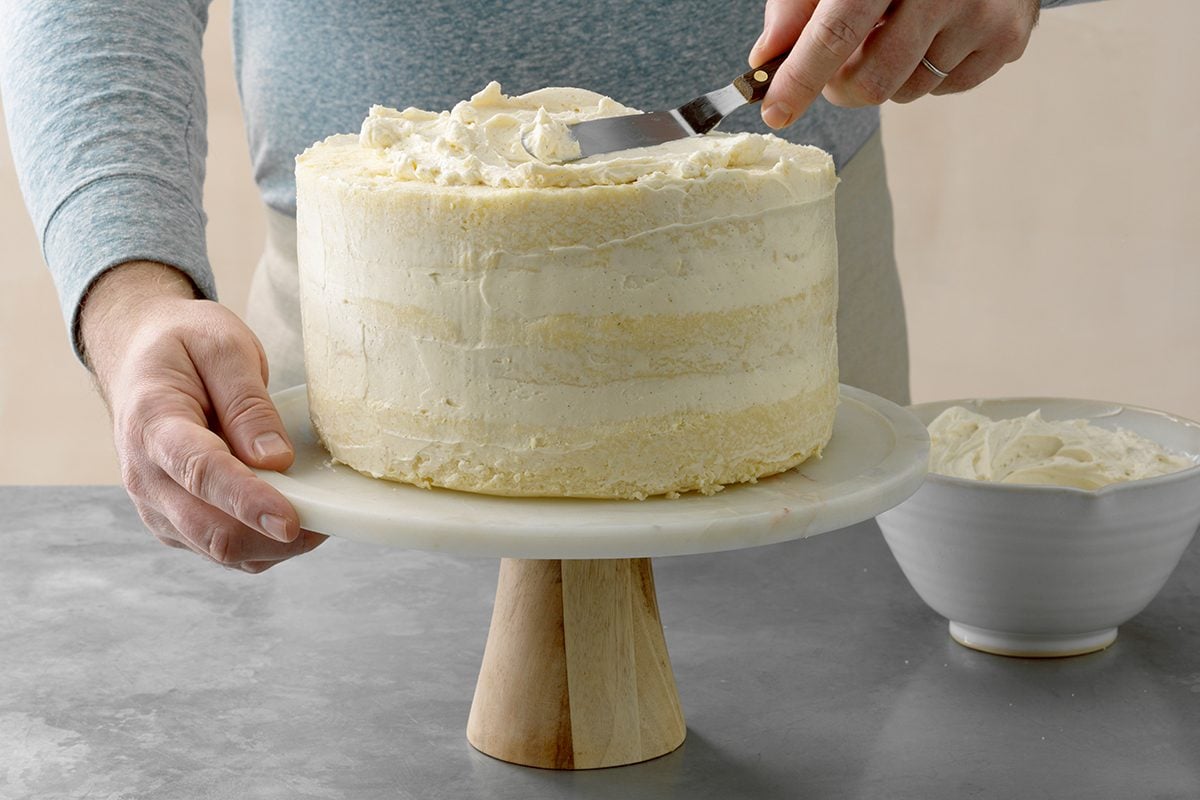
Then using an offset spatula—one of our favorite baking essentials—frost between the layers. Once your layers are stacked, you can give the outside a quick crumb coat. A crumb coat is just a very thin layer of frosting that you spread over the whole cake. This thin coating helps contains any crumbs (hence the name) and serves as a good base for further decorating.
With the crumb coat finished, you can frost the outside however you like. You can opt for fancy piping or just simple swirls using that offset spatula. This cake will be gorgeous however you finish it.
Editor’s tip: You can learn about frosting a cake in-depth with our tutorial.
The Finished Cake: Total Perfection for Any Special Occasion

Slice into this moist vanilla cake and you’ll be shocked it’s not from a bakery. The flecks of vanilla bean from the vanilla paste give it that decadent look and just makes your mouth water at what’s to come.
You can serve this cake up plain, but it would be divine paired with some fresh berries spooned over the top or even a scoop of your favorite ice cream. And if you need tips on how to get the perfect slices of cake (and you’ll want them with this beauty), learn how to (easily) cut a cake.
Try More Gorgeous Layer Cakes

Years ago, I drove 4-1/2 hours to a cake contest, holding my entry on my lap the whole way. But it paid off. One bite and you'll see why this velvety beauty was named the best chocolate cake recipe won first prize. —Sandra Johnson, Tioga, Pennsylvania
Get Recipe
This recipe truly lives up to its name. The pecan-dotted cake is stacked in three layers, and made-from-scratch frosting is the crowning touch.—Karen R. Jones, Claypool, Indiana
Get Recipe
If you want a
St. Patrick's Day dessert that will take the cake, look no further! The rich chocolate cake is incredibly moist and has a nice malt flavor that's perfectly complemented by the Irish cream frosting. —Jennifer Wayland, Morris Plains, New Jersey
In our family no one thinks it’s Christmas without this Red Velvet Cake recipe. I baked the first one for Christmas in 1963 when I found the recipe in the newspaper and my Mother kept the tradition going into the ’80s. It’s different than other Red Velvet Cakes I’ve tasted over the years, since this one tastes only mildly chocolate and the icing is as light as snow. —Kathryn H. Davison, Charlotte, North Carolina
Get Recipe
I found this recipe back in the late '80s and knew it was a special cake. The caramel icing can be a little tricky because you have to work quickly, but it's so worth it! —Mariann James, Ferguson, Missouri
Get Recipe
Most cake recipes feed a crowd. So we came up with this elegant little cake that serves six. That's enough for two…with just the right amount of leftovers! —Taste of Home Test Kitchen
Get Recipe
My sister gave me the recipe for this beautiful cake years ago. The thin layer of frosting spread on the outside gives it a chic modern look. —Lynn Glaze, Warren, Ohio
Get Recipe
This chocolate cake recipe with coffee reminds me of my grandmother because it was one of her specialties. I bake it often for family parties, and it always brings back fond memories. The cake is light and airy with a delicious chocolate taste. This recipe is a keeper! —Patricia Kreitz, Richland, Pennsylvania
Get Recipe
Pecans and butter give this cake the same irresistible flavor as the popular
butter pecan ice cream flavor. —Becky Miller, Tallahassee, Florida
My grandmother made up this recipe for her children. Using Ozark-grown cherries and walnuts, she invented one they all liked. Granny always used cream from the dairy farm near her home, but the half-and half works well and is easier to find. —Diana Jennings, Lebanon, Missouri
Get Recipe
When I need an impressive dessert for a special occasion, this is the recipe I depend on. My guests are glad I do! —Edna Hoffman, Hebron, Indiana
Get Recipe
Don't let the number of steps in this recipe fool you —it's easy to assemble. The cake bakes up high and fluffy, and the berries add a fresh fruity flavor. Cream cheese is a good substitute if you don't have mascarpone cheese handy. —Carol Witczak, Tinley Park, Illinois
Get Recipe
Pound cake and chocolate make the best marble cake. — Ellen Riley, Birmingham, Alabama
Get Recipe
Whenever I take this eye-catching torte to a potluck, I get so many requests for the recipe. —Edith Holmstrom, Madison, Wisconsin
Get Recipe
If you love a moist and creamy cake, this is it. Lemon juice and lemonade give the layers a tangy touch, and the cream cheese frosting with sprinkles makes it pretty. —Lauren Knoelke, Milwaukee, Wisconsin
Get Recipe
My husband constantly requests this homey, old-fashioned version of carrot cake. The frosting is still tasty even without the pecans. —Adrian Badon, Denham Springs, Louisiana
Get Recipe
I once sent this rich chocolate cake to my kids' teachers, and it vanished, so I had to make another one. (Who swipes a whole cake?) —Megan Moelbert, Springville, NY
Get Recipe
This recipe is a family gem that was passed down from my grandmother and mother. Garnished with shaved lemon zest, the moist four-layer cake is the perfect dessert when you want to impress. —Nanette Slaughter, Sammamish, Washington
Get Recipe
The combination of mocha and peanut butter will satisfy every sweet tooth at your table. The garnish is a little extra work, but what are special occasions for? —Tammy Bollman, Minatare, Nebraska
Get Recipe
I’d never tasted an Italian cream cake before moving to Colorado. Now I bake for people in the area, and this beauty is one of my most requested treats. —Ann Bush, Colorado City, Colorado
Get Recipe
This recipe is my mother's oldest and most popular chocolate cake recipe. I always thought it should have a fancier name, but this is what she called it. Mom would say a fancy name would not make it taste better. —Beth Bristow West Plains, Missouri
Get Recipe
This moist cake with cream cheese frosting is the best I've ever eaten. It's so simple, too, because it uses two jars of baby food instead of fresh carrots that need to be grated. —Jeanette McKenna, Vero Beach, Florida
Get Recipe
I adapted a Bundt cake recipe to create this layer cake. Cranberries, walnuts and homemade frosting make it taste so delicious that you'd never guess it starts with a convenient cake mix. —Sandy Burkett, Galena, Ohio
Get Recipe
Whenever I get a craving for a tasty old-fashioned treat, I make this cake. Great cooks in my family have been baking it for generations, and their families have been enjoying the wonderful spice flavor and rich frosting. —Nancy Duty, Jacksonville, Florida
Get Recipe
You'll spend less than a half hour whipping up this cure-all cake that starts with a mix. Sour cream and
chocolate pudding make it rich and moist, and chocolate, chocolate and more chocolate make it decadent
comfort food at its finest. —Taste of Home Test Kitchen
This citrusy cake with a luscious cream cheese frosting will garner plenty of raves. The flavor, a duet of sweet and tangy notes, really sings. —Summer Goddard, Springfield, Virginia
Get Recipe
This impressive hummingbird cake is my dad’s favorite, so I always make it for his birthday. It makes a memorable dessert for any celebration and is lovely with a
summer meal. —Nancy Zimmerman, Cape May Court House, New Jersey
One of my mom's friends gave her this recipe when I was a child and it has been a family favorite ever since. When your "
chocolate sweet tooth" acts up, this really hits the spot! —Linda Yeamans, Ashland, Oregon
No one will guess this showstopper dessert with luscious cinnamon frosting starts with a mix! It's a year-round favorite. —Linda Murray, Allenstown, New Hampshire
Get Recipe
This decadent triple-layer beauty is pure chocolate indulgence. The cake layers can be frozen prior to final assembly; in fact, they're easier to work with when frozen. —Kathleen Smith, Overland, Missouri
Get Recipe
I just love this
southern-style dessert, and so do dinner guests. With pecans, cherries and raisins in the filling and topping, this version reminds me of a fruitcake—only so much better! —Mabel Parvi, Ridgefield, Washington
This two-layer beauty features a striking red interior. It calls for more baking cocoa than most red velvet cakes, making it extra chocolaty. Feel free to change the color of the food coloring to suit the occasion. I'm proud to say that this recipe won a blue ribbon in the holiday cake division at the 2006 Alaska State Fair. I think this award winning red velvet cake recipe will be a winner in your house, too! —Cindi DeClue, Anchorage, Alaska
Get Recipe
I won grand champion honors in a potato festival baking contest with this moist chocolate cake. The icing recipe can be doubled for real sweet tooths. A great-grandma, I've spent over 85 years on the farm.
Get Recipe
This maple-flavored cake with candied walnuts honors my grandpa, who used to
make maple syrup. —Lori Fee, Middlesex, New York
Cherry cola and marshmallows make a zippy chocolate dessert that is scrumptious topped with
vanilla ice cream. — Cheri Mason, Harmony, North Carolina
My mom made this for me, and one bite can completely take me back to my childhood. You can easily convert it into a great carrot cake recipe: just use grated carrots in place of pumpkin and add raisins. —Melissa Pelkey Hass, Waleska, Georgia
Get Recipe
I get lots of compliments and recipe requests whenever I make this eye-catching cake. The filling is similar to
German chocolate cake. —Judy Lamon, Louisville, Tennessee
If you like cookies-and-cream ice cream, you'll love this cake.
Chocolate sandwich cookies are mixed into the batter and pressed into the sweet and creamy frosting for a fun look. —Pat Habiger, Spearville, Kansas
Toasted coconut adds visual appeal to this tall and impressive cake. With an airy texture and heavenly coconut-ginger flavor,it's a lovely end to meals throughout the year.
Get Recipe
If you love chocolate, you will LOVE this cake. I found this recipe when looking for a special cake to make my chocolate-loving daughter-in-law's birthday. Be sure to give the pudding and the cake enough time to cool or the end results will be disappointing. —Donna Bardocz, Howell, Michigan
Get Recipe
The post How to Make the Best Vanilla Cake You’ve Ever Tasted appeared first on Taste of Home.
Lisa Kaminski























